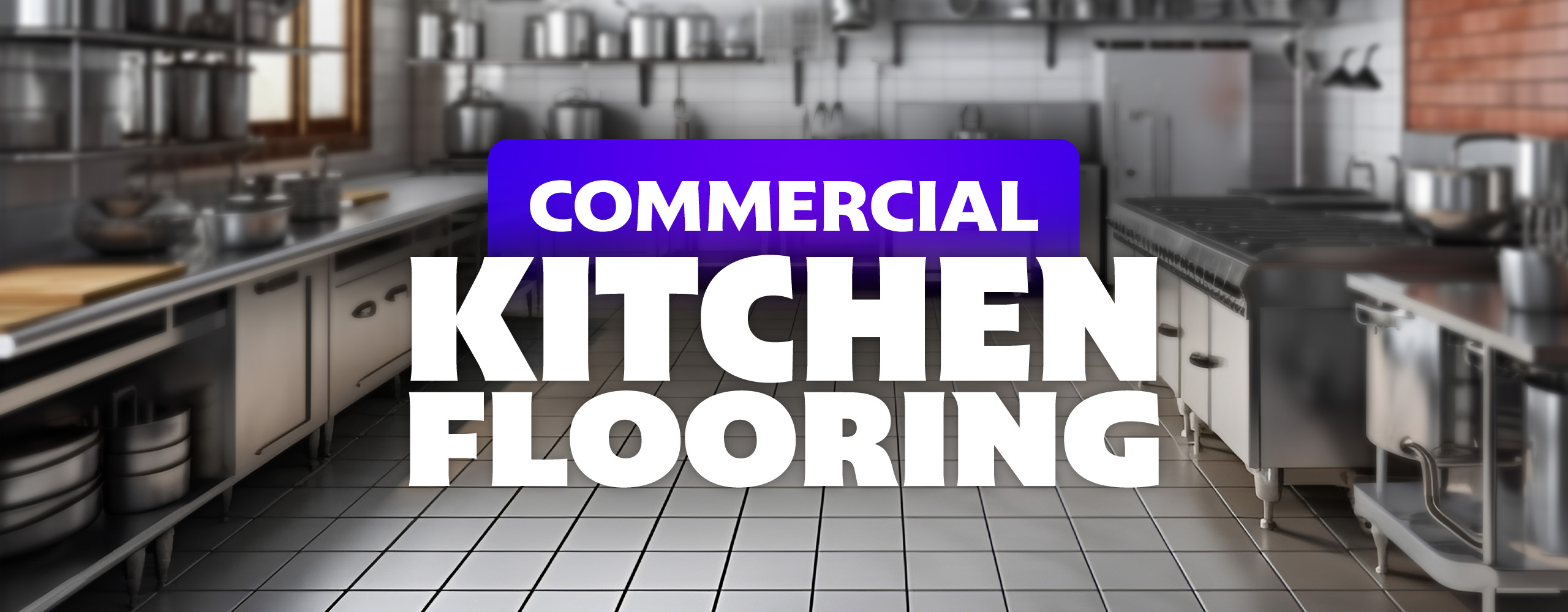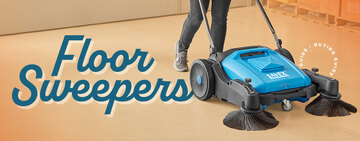
Choosing the right type of flooring for your commercial kitchen is a critical decision that can impact the safety, efficiency, and longevity of your operation. Your kitchen floors are subjected to high levels of foot traffic, spills, and the weight of heavy equipment. Floors must be slip-resistant, easy to clean, and able to withstand the demands of a busy kitchen environment. If you're starting a new restaurant or performing renovations on your existing business, use this guide to learn about the different types of flooring available to you.
Commercial Kitchen Flooring Requirements
When you're installing new floors in your commercial kitchen, you should be on the lookout for certain qualities that will make the flooring practical for a back-of-house environment.
- Durability: Commercial kitchen flooring must be able to withstand heavy foot traffic, spills, and constant cleaning. Look for materials that are resistant to scratches, stains, and moisture.
- Slip Resistance: Safety is paramount in a kitchen environment, so choose flooring that offers excellent slip resistance to prevent accidents and injuries.
- Easy to Clean: Hygiene is crucial in a commercial kitchen, so opt for flooring that can be easily cleaned and sanitized to maintain a clean and sanitary environment.
- Chemical Resistance: Commercial kitchens often use harsh cleaning chemicals, so the flooring should be resistant to chemicals and acids to prevent damage.
- Heat Resistance: With hot equipment and cooking processes in a kitchen, the flooring should be able to withstand high temperatures without warping or melting.
- Noise Reduction: A busy kitchen can be loud, so consider flooring materials that help absorb sound to create a more comfortable working environment.
- Compliance with Health Codes: Ensure that the flooring meets health and safety regulations set by local authorities to avoid any violations.
Types of Commercial Kitchen Floors
Safety is a top priority in any commercial kitchen. The right type of flooring can help prevent slips and falls, which are one of the leading causes of workplace injuries in the foodservice industry. Proper kitchen flooring also contributes to the overall cleanliness and hygiene of your establishment.
1. Quarry Tile

If you've ever stepped foot into a commercial kitchen, you will recognize this reddish-orange tile. Quarry tile is a popular choice for commercial kitchen flooring because it's durable and resistant to moisture, heat, and heavy foot traffic. Made from natural clay and shale, quarry tile is fired at high temperatures, resulting in a dense and hard surface.
In terms of size and shape, quarry tile is commonly available in square or rectangular pieces, with dimensions ranging from small tiles to larger slabs. The edges of quarry tiles are usually straight and precise, allowing for a seamless and uniform installation.
- Benefits of Quarry Tile: Affordable, slip-resistant, durable, stain-resistant.
- Best Applications for Quarry Tile: Commercial kitchens with heavy foot traffic, pizzerias, and bars.
- How to Clean Quarry Tile: Sweep or vacuum daily, mop with a neutral cleaner and hot water.
2. Ceramic Tile

Ceramic tile flooring is a timeless and hygienic option for commercial kitchens, providing a durable and easy-to-clean surface. Made from clay and other natural materials, ceramic tiles are resistant to heat, moisture, and stains, making them suitable for food preparation areas. Despite its durability, ceramic tile flooring may not be recommended for areas where heavy objects are frequently dropped as tiles can crack or chip upon impact.
If you're choosing between quarry tile and ceramic tile, you'll find a wider selection of colors and finishes with ceramic. Quarry tile isn't as aesthetically pleasing, but it's thicker and more durable.
- Benefits of Ceramic Tile: Available in a variety of colors, sizes, and patterns. Resistant to stains, moisture, and heat.
- Best Applications for Ceramic Tile: Restrooms, prep areas, dining areas, and entryways.
- How to Clean Ceramic Tile: Sweep or vacuum daily, mop the floor with a mild detergent and warm water. Avoid using harsh chemicals or abrasive cleaners.
3. Commercial Vinyl Flooring

Vinyl flooring technology has come a long way in recent years. Luxury vinyl tile (LVT) and sheet vinyl flooring are ideal for commercial kitchens because of their durability, water resistance, and ease of maintenance. Most importantly, they can be treated for slip resistance to prevent common kitchen injuries like slips and falls. Made from synthetic materials, vinyl flooring is available in a range of styles, colors, and patterns. Its non-porous surface helps prevent the growth of bacteria and is easy to clean, making it ideal for foodservice environments.
- Benefits of Vinyl Flooring: Affordable, easy to install, and resistant to stains and moisture. Sheet vinyl is seamless, making it easy to clean.
- Best Applications for Vinyl Flooring: Fast-food restaurants, bakeries, and cafeterias.
- How to Clean Vinyl Flooring: Sweep or vacuum daily, mop with a mild detergent.
4. Concrete Flooring

Concrete flooring is a sturdy and versatile option for commercial kitchens, offering a durable surface that can withstand heavy equipment and high traffic. Composed of cement, sand, and aggregates, concrete flooring can be customized with finishes like staining or polishing to enhance its appearance and durability. Its seamless design and resistance to heat and moisture make it a practical choice for foodservice establishments.
Concrete flooring may not be ideal for areas with heavy foot traffic or where prolonged standing is required because it can be hard on the feet and joints. We recommend using anti-fatigue mats for your line, prep, and dish areas.
- Benefits of Concrete Flooring: Extremely durable, seamless for easy cleaning, resistant to heat and moisture.
- Best Applications for Concrete Flooring: Large high-volume kitchens with a lot of heavy equipment.
- How to Clean Concrete Flooring: Consider applying a sealant periodically, sweep daily, mop with a neutral cleaner and hot water, and regularly inspect for any cracks, chips, or uneven areas that may pose a safety hazard.
5. Rubber Flooring

Rubber flooring is a cushioned and slip-resistant option that provides comfort for kitchen staff and enhances safety. Made from natural or synthetic rubber, this flooring material is resilient, absorbent, and easy to clean. Its shock-absorbing properties make it a suitable choice for reducing fatigue and noise in commercial kitchens.
While rubber flooring is suitable for most kitchen environments, it may not be recommended for areas where oils and fats are frequently spilled as it can become slippery and may break down the flooring over time.
- Benefits of Rubber Flooring: Shock-absorbent, noise-reducing, easy to maintain.
- Best Applications for Rubber Flooring: Commercial kitchens with heavy equipment, bars, coffee shops.
- How to Clean Rubber Flooring: Sweep or vacuum regularly, mop with a mild detergent solution, and avoid abrasive cleaners.
6. Epoxy Flooring

Epoxy flooring is a resin-based material that is poured and cured on-site, creating a seamless and durable surface. It's a non-porous option that provides excellent resistance to chemicals, water, and impact. Epoxy flooring is easy to clean and maintain in busy kitchen settings.
Because epoxy floors are water-tight, they can become slippery when wet. The water has nowhere to go, so it will form a pool on the surface of the floor. To minimize this issue, look for epoxy options that feature non-slip coatings.
- Benefits of Epoxy Flooring: Chemical-resistant, seamless, customizable colors and designs.
- Best Applications for Epoxy Flooring: Industrial kitchens, food processing facilities, breweries.
- How to Clean Epoxy Flooring: Sweep or vacuum regularly, mop with a mild detergent and water, and avoid harsh chemicals.
The type of flooring you select plays a vital role in the day-to-day operations of your kitchen. By opting for durable, slip-resistant, and easy-to-clean flooring options, you can create a workspace that not only meets industry regulations but also enhances the productivity of your staff.





